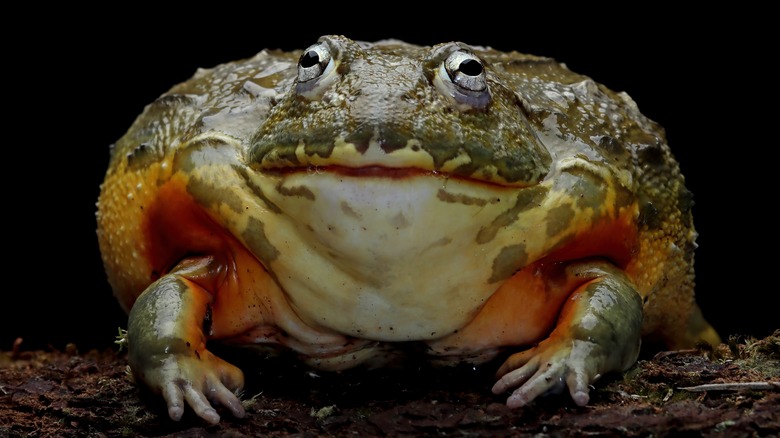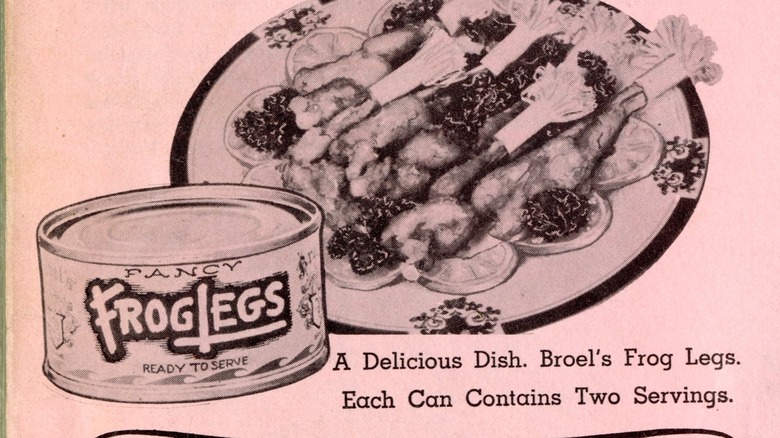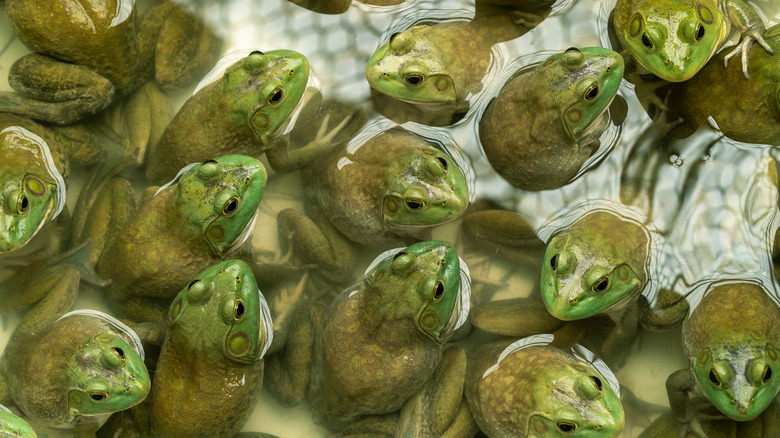The Wild History Of The Canned Frog Industry
It's the 1930s: Stocks are falling, businesses are failing, and a quarter of all workers are unemployed. Many are losing their homes. But, one man put an ad in the paper promising easy, pleasant, outdoor work generating quick, easy, sustainable money — seemingly promising to pull anyone out of the Great Depression. All you have to do is write to Albert Broel, founder of the American Frog Canning Company, requesting a free book on raising bullfrogs (and buy five breeding pairs of Nufond Giant frogs), and you could earn over $4,000 a year (almost $90,000 in 2024).
The canned frog industry was huge in the late 19th and early 20th century, and frogs' legs were a popular delicacy. Louisiana — Rayne township, in particular — became the global epicenter of the frog trade. Donat Pucheu began catching wild bullfrogs and selling them to New Orleans restaurants in the 1880s; soon after, the Weills Brothers started exporting Louisiana frog legs all over the U.S. and to France. And, by 1937, the Louisiana Frog Company Plant shipped out more than 500,000 frogs.
Newspaper articles around the country touted success stories, and companies attracted investors to cash in on frog farming. As local populations dwindled, Broel ran ads nationwide, and live frogs began pouring into his cannery. It seemed that the industry was hopping. And then Broel was arrested for fraud.
A bunch of bullfrogs
Albert Broel didn't start his career with frog canning, but he was no stranger to murky business dealings. He had a medical practice as a naprapath but closed it when he was caught operating without a proper license. He started a personal ads service for wealthy singles that aided the serial killer Harry Powers — allegedly unknown to Broel — and shut it down during an investigation. He allegedly staged his attempted kidnapping and assault a year later (for reasons unknown). Eventually, he began canning frogs in Ohio with great success and then moved to Louisiana for better bullfrogs — and because Ohio wouldn't license his facility.
His canning company in Louisiana grew so rapidly that he needed to expand beyond his own farm and local hunters. Broel ran ads and sold books on raising frogs hoping to ignite the frog ranching industry and create a better supply stream for his company.
Thousands bought Broel's courses and books; he allegedly made $15,000 (almost $336,000 in s 2024) in just four months selling the "get rich quick" scheme, printing things like frog meat could aid in curing diabetes and how in one decade a frog farmer could make $360 billion. He was indicted for misleading and false advertisements by the U.S. Postal Service and federal prosecutors in Ohio and received a cease-and-desist from the Federal Trade Commission. He stated that he never meant to endorse the claims — it should have been clear that it was ridiculous. Sadly, many still bought into the scheme.
An unlikely business
Frog farming is a lot harder than Albert Broel made it out to be. Frogs eat nearly three times their marketable weight in live prey. If they don't get enough live prey, they'll eat each other. Diseases can quickly wipe out thousands of frogs at a time and, contrary to Broel's promises, it can take three years for the crop of frogs to be ready for market.
According to the USDA, there were "only three persons or institutions claiming any degree of success" (via Atlas Obscura) in the 1930s during the frog farming craze. It was a pyramid scheme with Broel at the top and nearly everyone failed. Between regulations enacted in the late '30s protecting wild populations and the failure of most farms, Broel couldn't keep up with demand and eventually closed up shop.
There was a resurgence of frog-farming dreamers in the 1970s and '80s. A 1978 article from Mother Earth News quoted Leonard Slabaugh saying that he could get up to "$25 per frog" on his little two-acre farm. He also claimed that, with just an hour of work a day, he turned a profit of $20,000 every year (nearly $99,000 today).
These days, frog meat is still a $40 million-a-year industry. The major suppliers are primarily Asian countries — Bangaldesh, China, Indonesia, Japan, Taiwan as well as Belgium and Mexico. And, domestic frog farming is still as much a leap as ever.


